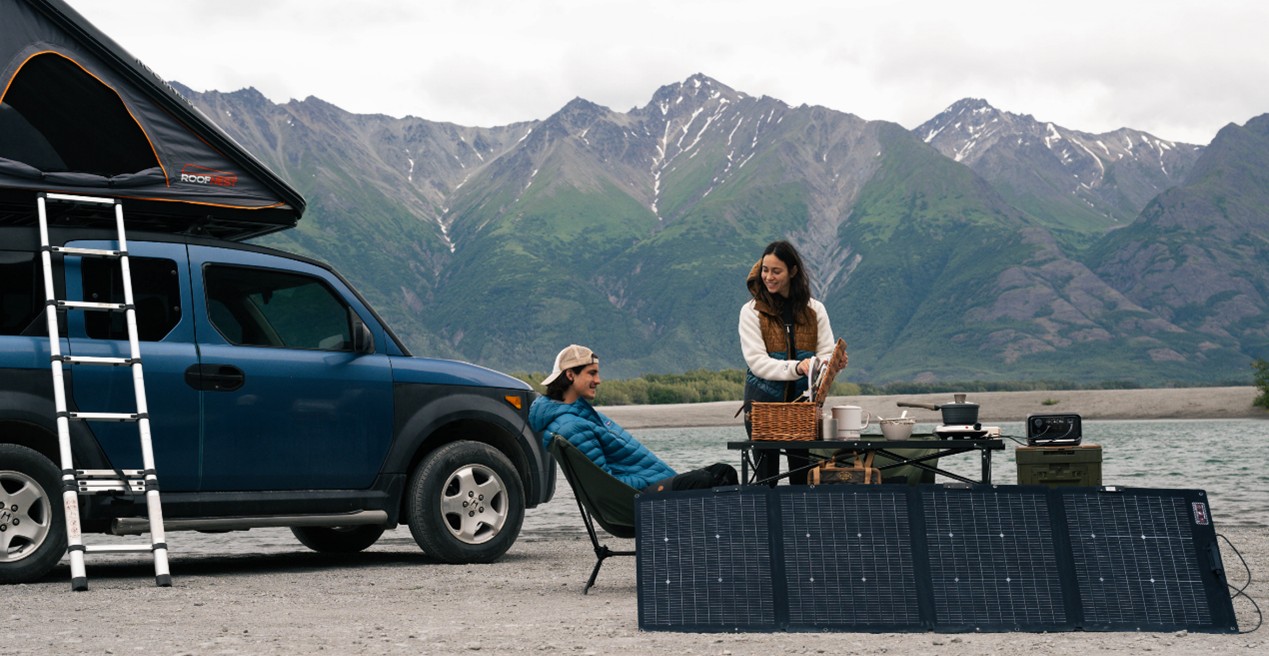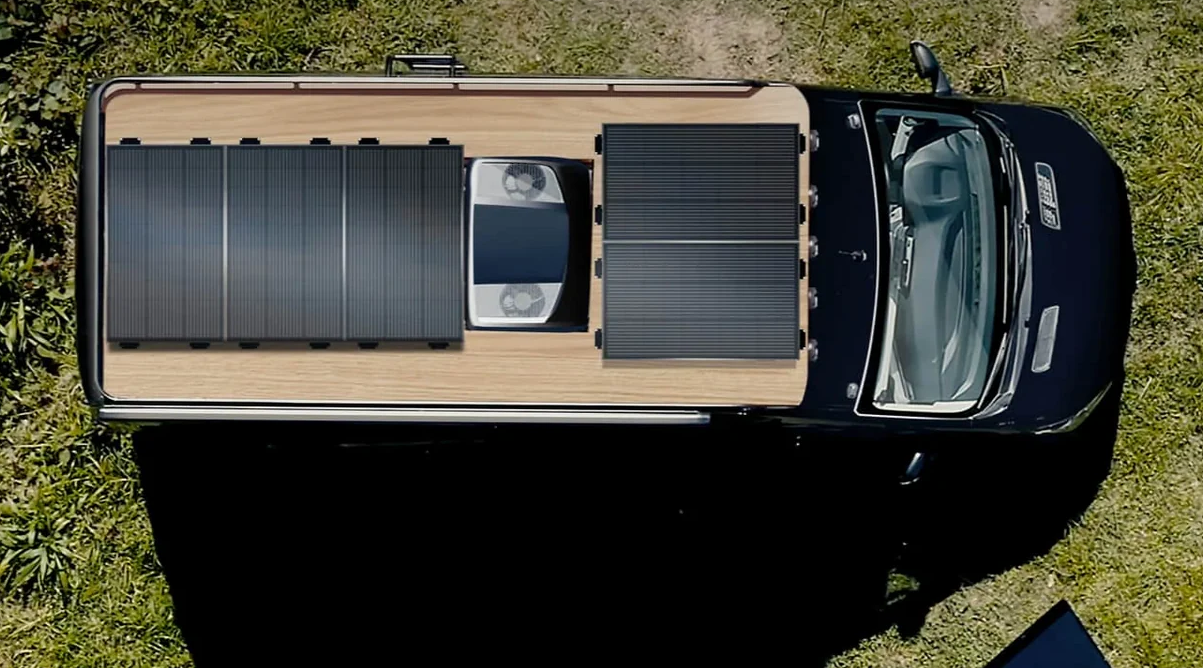A Full Guide to the Best Caravan Solar Panels
With the growing popularity of eco-friendly solutions, more caravan owners are investing in solar setups to power appliances and charge devices on the go. How do you choose the best caravan solar panels among so many options? This guide is here to help you make a more informed decision. It covers everything, from how caravan solar panels work and the types available, to power requirements and top product recommendations. Whether you’re a weekend explorer or a full-time van lifer, scroll down to find insights to power your journey ahead!
What Are Caravan Solar Panels?
Caravan solar panels are specially designed photovoltaic (PV) systems that harness sunlight to generate electricity for 4WD vehicles, like caravans, motorhomes, and RVs. They typically consist of solar panels, a charge controller, and a battery bank.
Unlike home solar systems, these panels are typically installed on the roof of your caravan or used as standalone foldable units you can deploy at your campsite. They capture solar energy through solar cells and transfer it to a battery for storage, which can then power lights, fridges, fans, and even charging stations for phones and laptops.
Caravan solar panels are compact, lightweight, and built for mobility. Whether for complete energy independence or just to reduce your reliance on campsite hookups, caravan solar panels will keep your travels powered.
How Do Caravan Solar Panels Work?
Caravan solar panels convert sunlight into electricity to power your mobile setup. They usually work alongside a charge controller and battery to store and manage the energy. If you need to run appliances that require AC power, an inverter is added to convert the stored DC power into AC. Here’s a simple breakdown of how the system functions.
Solar Panels: Whether foldable or mounted on your caravan’s roof, these solar panels serve as collectors. When sunlight hits photovoltaic cells in panels, it excites tiny particles called electrons and creates a flow of direct current (DC) electricity.
Charge Controller: The DC electricity from the solar panels goes to a charge controller. This clever device acts as a guardian for your batteries. It regulates the voltage and current, ensuring the batteries are charged safely and efficiently without overcharging, which can damage them.
Batteries: The regulated DC power from the charge controller then flows into your caravan’s leisure batteries. These batteries store the generated electricity so you have power even when the sun isn’t shining, like at night or on cloudy days. You can also add portable power stations for extra power storage. It ensures extended use for camping, outdoor events, or charging from a mains socket when available.
Inverter (optional): Many caravan appliances run on alternating current (AC). Since solar panels and batteries produce DC, an inverter is often used to convert the DC power from the batteries into AC power, allowing you to use standard devices like laptops or small TVs. Therefore, though an inverter is optional, experienced outdoor lovers don’t hesitate to invest in one.
Types of Solar Panels for Caravans
Understanding the different types available is key to choosing the best caravan solar panels. So far, they are categorized by material and physical flexibility. Each comes with unique benefits depending on your needs.
Solar Panel Types by Material
The core material used in solar cells dictates a panel’s efficiency, cost, and appearance. There are 3 main types in the market.
Monocrystalline Panels
Monocrystalline panels are made from a single, high-purity silicon crystal. They are generally the most efficient type available and perform well in bright, direct sunlight. This high efficiency makes them ideal for caravans with limited roof space. Also, they typically come at a higher price point.
Polycrystalline Panels
Distinguished by their blue, speckled appearance and square cells, polycrystalline panels are made from multiple silicon crystals melted together. They are cost-effective and offer good performance. Thus, they are a popular choice for caravan owners looking for a balance between cost and efficiency.
Thin-Film Panels
These panels deposit very thin layers of photovoltaic material, like amorphous silicon, cadmium telluride, or copper indium gallium selenide, onto a substrate. They are typically less efficient than both mono and polycrystalline types. However, they are lightweight and flexible, and can sometimes perform better in low-light conditions or partial shading.
Solar Panel Types by Flexibility
The physical form factor of a solar panel is also a significant consideration for caravan applications. It influences mounting options and aesthetics significantly.
Rigid Panels
These are the most common solar panels for caravans. Typically framed with aluminum and covered with tempered glass, they are robust, durable, and offer excellent long-term performance. Rigid panels are designed for fixed installation and usually mounted directly to the caravan’s roof using brackets.
Flexible Panels
Flexible panels are much lighter and thinner than rigid panels, often using a durable plastic or polymer instead of glass. As the name suggests, these panels are designed to bend and conform to slightly curved surfaces. They are portable solar panels for caravans, perfect for those who prefer a less conspicuous installation.
How Much Power Do You Need for Your Caravan Setup?
If you decide to invest in solar panels for your caravan, you need to determine how much solar power you need, which depends on your typical energy usage while traveling. You can start by listing all the appliances and devices you’ll be running, including lights, fridge, phone chargers, laptops, or a water pump, and note their wattage and daily usage time. Below is an example showing how to calculate the daily power needs for your reference:
LED lights (20W) × 4 hours = 80Wh
Portable fridge (50W) × 24 hours = 1,200Wh
Laptop (60W) × 2 hours = 120Wh
Total estimated daily usage = ~1,500Wh (or 1.5kWh)
Theoretically, you’ll need solar panels that generate at least 1.5 kWh to support the listed devices. It’s also generally recommended to oversize your system by 20% or more to account for cloudy days and less-than-ideal panel angles. So, you may need 1.5 – 1.8 kWh per day. The more devices and the longer you need to power, the more power it requires.
Tips: To handle any unexpected situations on the go, a portable power station is also recommended to store extra power for extended use.
What Other Things to Consider When Choosing Caravan Solar Panels?
Besides power output, several other factors influence the performance and practicality of your caravan solar panel kit. Taking them into account will help you choose a solar panel system that’s reliable, long-lasting, and perfect for your mobile lifestyle.
Panel Size & Space Availability: Make sure the panel dimensions fit your caravan roof or chosen mounting surface without overcrowding.
Ease of Installation: Some panels come with plug-and-play kits, while others may need professional fitting. Choose based on your DIY comfort level.
Durability: Look for panels that are weatherproof, UV-resistant, and made to withstand road vibrations.
Compatibility with Solar Batteries: Ensure the panel works well with your battery or power station for optimal energy storage and use.
Budget: Balance cost with efficiency, build quality, and longevity. Sometimes, spending a bit more upfront saves you hassle down the road.
Best Caravan Solar Panels
Here are the top 3 solar panels for caravans from EcoFlow. If you’re new to the solar field and don’t know where to start, just pick one for a try.
EcoFlow 400W Portable Solar Panel
For caravan owners seeking a robust and versatile off-grid power solution, the EcoFlow 400W Portable Solar Panel is the best portable caravan solar panel kit. Made of multi-busbar monocrystalline cells, it stands out for its impressive 400W output and high 23% conversion rate. This ensures rapid charging, even in less-than-ideal conditions. The creative carry case also adds to the portability. It’s more than a protective layer for this unique folding panel. It also serves as a sturdy supporting stand to help you place the panel anywhere at the most suitable angle. You can enjoy the greatest convenience and portability.
Who is it for:
Great for digital nomads, long-term caravanners, remote campers, and anyone requiring substantial portable power without permanent roof installations.
EcoFlow 400W Portable Solar Panel
EcoFlow NextGen 220W Bifacial Portable Solar Panel
The EcoFlow NextGen 220W Bifacial Portable Solar Panel is a compact, flexible unit with a high 25% conversion efficiency. The innovative bifacial design makes it possible to harness sunlight from both the front and rear sides. What’s more, you can adjust the panel angle by 30 degrees in seconds to get the most sunshine at all times. With premium tempered glass & ETFE coating, it is also built to last. Paired with an IP68 waterproof rating, you can expect optimal performance anywhere.
Who is it for:
Best for backpackers, weekend adventurers, those with limited roof space, and users who frequently camp in varied environments.

EcoFlow 100W Rigid Solar Panel
The EcoFlow 100W Rigid Solar Panel is the perfect entry point into off-grid solar power, especially for those who prefer a durable solar solution on the go. The panel offers a strong 23% conversion rate and can provide enough energy to charge phones, power several LED lights, and perform other light tasks. Its robust, all-black design goes with almost all vehicles. You also don’t need to worry about the durability. It has an IP68 waterproof rating to withstand dirt, low-pressure water jets, extreme winds (up to 130 mph), and even heavy snowfall. This surely delivers peace of mind, even for long-term use!
Who is it for:
Best for weekend and occasional caravanners, those needing to maintain leisure battery health during storage, and users looking for a foundational solar system with a long lifespan.

Conclusion
Choosing the best caravan solar panels is essential for energy independence on the road. By understanding the types, power requirements, and top-performing models, you can be more confident in investing in a system that keeps your devices running and your adventures stress-free. If you’re overwhelmed by options, just turn to EcoFlow. The industry-leading brand offers reliable, high-efficiency solar solutions of all kinds. Explore the website today and hit the road with freedom and sustainability!
FAQs
What caravan solar panels are typically used for?
Caravan solar panels are primarily used to generate electricity for off-grid living. They power essential appliances like lights, fridges, water pumps, and TVs. Additionally, they are crucial for keeping the caravan’s leisure battery charged, preventing it from draining and extending its lifespan, especially during extended stays or storage.
How to improve the performance of caravan solar panels?
Here are some common methods to improve caravan solar panel performance.
Clean panels regularly: Dust, dirt, and debris significantly reduce efficiency.
Optimal positioning: Angle panels to face direct sunlight, adjusting throughout the day or season if possible. Avoid shadows from trees or roof accessories.
Minimize energy consumption: Use energy-efficient appliances (like LEDs) and monitor your power usage.
Proper wiring: Ensure correct cable gauge and secure connections to prevent power loss.
Besides regular maintenance, you can always consider high-efficiency monocrystalline panels, MPPT charge controllers (for better energy harvesting), and lithium-ion batteries (for better storage and discharge).
How many solar panels does my caravan need?
The number of solar panels your caravan needs depends on how much power you use each day. For light use like lights, phone charging, and a small fridge, a 200–300W setup may be enough. If you also run appliances like a TV or laptop, 400–600W is more realistic. Divide your total daily watt-hours by average sunlight hours (usually 4–6) and oversize the system by 20% for better reliability.